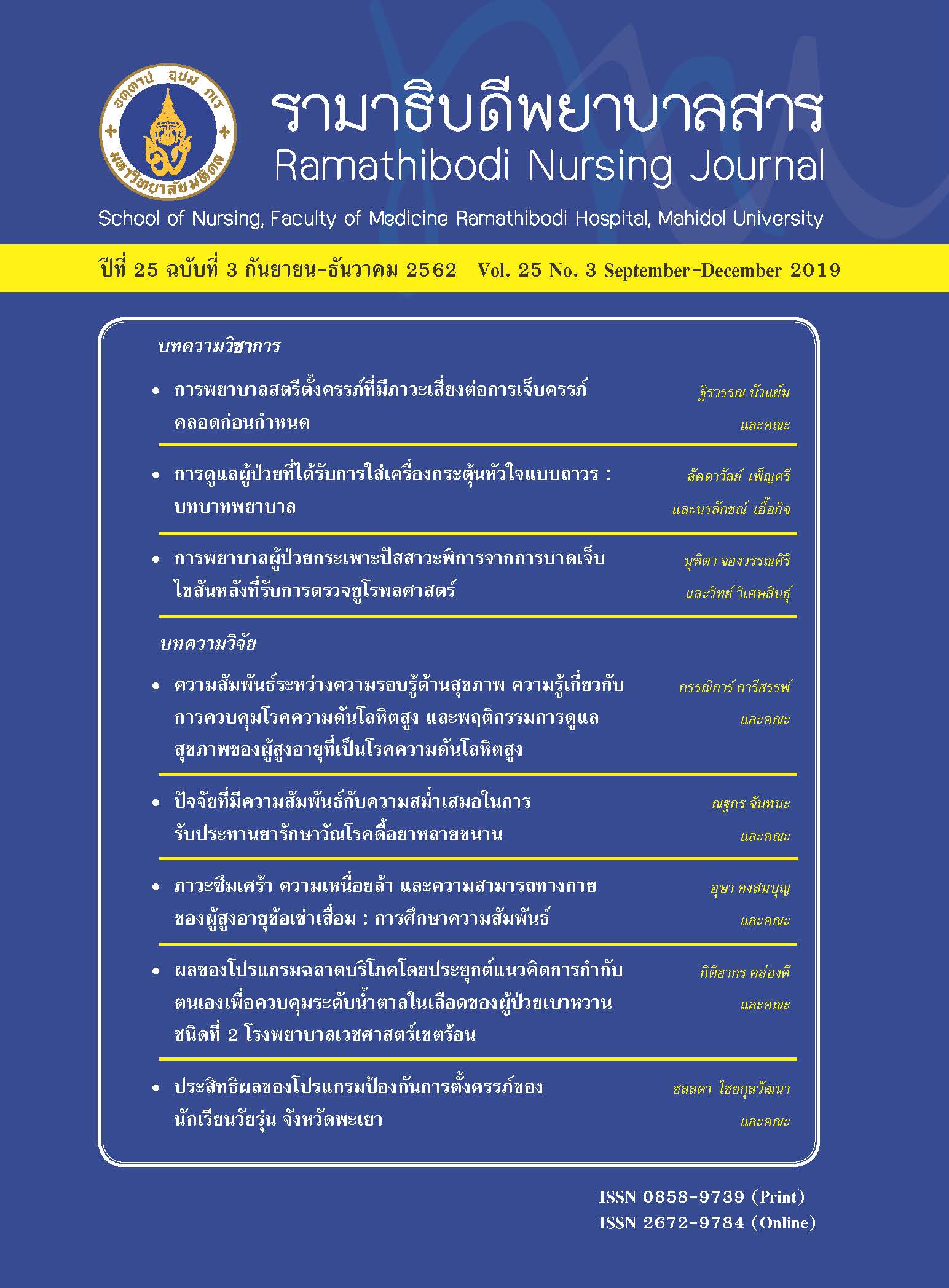Nursing Care for Pregnant Woman at Risk for Preterm Labour
Main Article Content
Abstract
Preterm birth is a major public health problem. Premature infants may have many complications due to the organs may not properly function. In addition, the family members have to lose their time and financial costs of caregiving for premature infants with the need for long-term care disability. Therefore, prevention of preterm birth is very important. In the beginning, the pregnant women who are at risk for preterm labor should be clearly defined and it is very necessary to ensure that these patients would be under effective treatments. Nurses are the first healthcare team who meet pregnant women while they come for the antenatal care and for follow-up appointment. Therefore, the crucial role of nurses in antenatal care is screening of pregnant women who are at risk for premature labor, assuring that these patients would be under effective treatments, and educating the patients to change their health behavior and self-care while they receive progesterone to prevent from a preterm birth. Nurses should educate pregnant women who are at risk for premature labor to be able to notice early signs and symptoms that may be occurred by themselves and come to the hospital in time for treatments. Accordingly, the nurses should support the husband and family members of the patients to take part in caring for a pregnant woman to trying to conceive with an increasing in a gestational age or to be continued to delivery.
Article Details
บทความ ข้อมูล เนื้อหา รูปภาพ ฯลฯ ที่ได้รับการตีพิมพ์ในรามาธิบดีพยาบาลสาร ถือเป็นลิขสิทธิ์ของวารสาร หากบุคคลหรือหน่วยงานใดต้องการนำทั้งหมดหรือส่วนหนึ่งส่วนใดไปเผยแพร่หรือเพื่อกระทำการใด ใด จะต้องได้รับอนุญาตเป็นลายลักษณ์อักษรจากรามาธิบดีพยาบาลสารก่อนเท่านั้น
References
2. The American College of Obstetricians and Gynecologists. Practice Bulletin No. 130: Prediction and Prevention of Preterm Birth. Obstet Gynecol. 2012;120(4):964-73.
3. Phuphong W. Preterm labor and delivery. In: PhuphongW, editor. Management of common problems in obstetrics.
Bangkok: The Royal Thai College of Obstetricians andGynaecologists; 2012. p.101-19. (in Thai)
4. Beck S, Wojdyla D, Say L, Betran AP, Merialdi M, RequejoJH, et al. The worldwide incidence of prete birth:asystematic review of maternal mortality and morbidity.Bull World Health Organ. 2010;88(1):31-8.
5. Blencowe H, Cousens S, Oestergaard MZ, Chou D, Moller AB, Narwal R, et al. National, regional, and worldwide
estimates of preterm birth rates in the year 2010 with time trends since 1990 for selected countries: a systematic
analysis and implications. Lancet. 2012;379 (9832):2162-72.
6. Department of Obstetrics and Gynecology, Faculty of Medicine Siriraj Hospital. Annual Statistical Report 2015:
Department of Obstetrics and Gynecology, Faculty of Medicine Siriraj Hospital. Bangkok: Department of Obstetrics and Gynecology; 2016.
7. Department of Obstetrics and Gynecology, Faculty of Medicine Siriraj Hospital. Annual Statistical Report 2016:
Department of Obstetrics and Gynecology, Faculty of Medicine Siriraj Hospital. Bangkok: Department of Obstetrics and Gynecology; 2017.
8. Department of Obstetrics and Gynecology, Faculty of Medicine Siriraj Hospital. Annual Statistical Report 2017:
Department of Obstetrics and Gynecology, Faculty of Medicine Siriraj Hospital. Bangkok: Department of Obstetrics and Gynecology; 2018.
9. American College of Obstetricians and Gynecologists. Preterm (Premature) labor and birth November 2016
[cited 2018 7 Aug]. Available from: https://www.acog.org/Patients/FAQs/Preterm-Premature-Labor-and-Birth.
10. Maternal Child Health Board, Professional Standards Subcommittee.RTCOG Clinical practice guideline: the management of preterm labour and preterm premature rupture of membranes. Bangkok: The royal thai college of
obstetricians and gynaecologists; 2015. (in Thai)
11. Cunningham FG. Williams obstetrics. 24th ed. New York: McGraw-Hill Education Medical; 2014.
12. Wanitpongpan P. Preterm Labour. In: Wanitpongpan P, Russameecharoen K, Lertbunnaphong T, editors. Modern
textbook of obstetrics. Bangkok: Department of Obstetricsand Gynaecology; 2017. p. 175-88. (in Thai)
13. Rueangdetnarong H, Tongsong T. Update in preterm labor 2016 [updated 2016 August 21 cited 2018 October
10]. Available from: https://www.med.cmu.ac.th/dept/obgyn/2011/index.php?option=com_content&view=
ar t i c l e & i d = 1 2 6 5 : u p d a t e - i n - p r e t e r m -labor&catid=45&Itemid=561. (in Thai)
14. World Health Organization. Born too soon: the global action report on preterm birth. Geneva: World Health
Organization; 2012.
15. Holbrook RH, Jr., Laros RK, Jr., Creasy RK. Evaluation of a risk-scoring system for prediction of preterm labor.
Am J Perinatol. 1989;6(1):62-8.
16. Tannirandorn Y. Premature birth: action to the best outcome. In: Uerpairojkit B, Tannirandorn Y, editors. The
royal thai college of obstetricians and gynaecologists conference; 2015 october 19; Dusit thani hotel Chon
buri2015. (in Thai)
17. Hassan SS, Romero R, Vidyadhari D, Fusey S, Baxter JK,Khandelwal M, et al. Vaginal progesterone reduces the
rate of preterm birth in women with a sonographic short cervix: a multicenter,randomized,doubleblind,placebo-controlled trial. Ultrasound Obstet Gynecol. 2011;38(1):18-31.
18. Schmouder VM, Prescott GM, Franco A, Fan-Havard P. The rebirth of progesterone in the prevention of preterm
labor. Ann Pharmacother. 2013;47(4):527-36.
19. Gray BA. A ticking uterus. How nurses can identify, treat and prevent preterm labor. AWHONN Lifelines.
2006;10(5):380-9.
20. Baosoung C. Nursing care for premature rupture of membranes and preterm labour. In: Sansiriphun N,Baosoung C, editors. Midwifery. 3 ed. Chiang mai:Krongchang printing; 2012. p. 121-38.(in Thai)
21. Thaingam S. The maternal periodontal disease and adverse pregnancy outcomes. Thai Dental Public Health Journal.
2010;15(1):18-26. (in Thai)
22. Lertbunnaphong T. Maternal body weight and pregnancy:factors that obstetricians may overlook. Siriraj Medical
bulletin. 2008;1(2):81-90. (in Thai)
23. Pinchaleaw D. Nurses and management of iron deficiency anemia in pregnant woman. Journal of The Police Nurses.
2017;9(2):195-202. (in Thai)
24. Kyrklund-Blomberg NB, Granath F, Cnattingius S. Maternal smoking and causes of very preterm birth. Acta
Obstet Gynecol Scand. 2005;84(6):572-7.
25. Hamulka J, Zielinska MA, Chadzynska K. The combined effects of alcohol and tobacco use during pregnancy on
birth outcomes. Rocz Panstw Zakl Hig. 2018;69(1):45-54.
26. Department of Labour Protection and Welfare. Protection of employees during pregnancy [cited 2019 Feb 15].
Available from: https://www.labour.go.th/th/index.php?option=com_content&view=article&id=60&Item id=94. (in Thai)
27. Jones C, Chan C, Farine D. Sex in pregnancy. CMAJ.2011;183(7):815-8.
28. Chawanpaiboon S. Preterm labour course and prevention in secondary and tertiary hospital 2016 [cited 2018
November 20]. Available from: https://tmchnetwork.
com/node/136. (in Thai)


